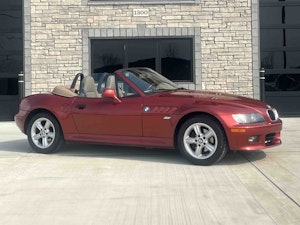Media | Articles
Commie cars invade capitalist capital
Most days, the street in front of the National Portrait Gallery in Washington, D.C., is devoid of smoke-belching East German economy cars. But once a year, the International Spy Museum, just across the street, hosts the Parade of Trabants, a celebration both of the archetypal Cold War family car and the fall of the Berlin Wall. This year marked the 11th such event, which attracted about two dozen Trabant owners from all over the eastern half of the U.S.
“When we started doing this, we just loved the Trabant community, so we decided to camp it up,” said Amanda Ohlke, the Spy Museum’s adult education director and the parade director. In years past, the museum has put together Trabant-stuffing competitions (they once crammed 16 people into one of the diminutive cars). It still provides cramped, open-sided wooden boxes for people curl into, a simulation of the experience of hiding in a Trabant to escape East Germany. (Because the low-power engine didn’t create much heat, some people hid in the engine compartment.) As always, the ceremony of driving of a Trabant through a mock Berlin Wall made of cardboard boxes gets a lot of attention.
20171117134447)
During the Cold War, a time when Americans were buying huge, shiny, gas-guzzling cars in ever increasing numbers, East Germans had to get along with less. Take the Trabant, the cotton-fiber-bodied econo-tub that most families had to wait as long as 15 years to obtain. Powered by a two-stroke, two-cylinder engine that sounded more like an anemic chainsaw than the motive power source for a family car, the Trabant was the most that East Germany’s war-ravaged auto industry could muster. It changed little over its 30-plus years in production, but a four-stroke Volkswagen engine replaced the original from 1989 until the end of the line in 1991.
“Trabants were symbolic of East Germany’s limited production capability, but now, they’re associated with the iconic images of East Germans driving their Trabants freely through the Brandenburg Gate after the fall of the Berlin Wall,” said Vince Houghton, the museum’s historian and curator. “By the end of the Cold War, East Germany was decades behind West Germany.”
Marketplace
Buy and sell classics with confidence
Houghton was speaking, of course, of the “Trabi Trail”—the post-Berlin Wall exodus of East Germans in search of more prosperous lives in West Germany. Indeed, the sight of an armada of Trabants, all brimming with passengers and belongings and spewing clouds of the two-stroke engine’s signature blue smoke, must have been something to behold.
20171117135217)
20171117141922)
When the first Trabant was introduced in 1957, it was—aside from its feeble, low-cost engine—an advanced economy car relative to what was available at the time. It boasted front-wheel drive, seating for five (sort of) and a lightweight plastic body that was impervious to rust. By the time the last Trabant rolled off the assembly line in 1991, the car was terribly anachronistic. Trabant engineers tried to update it, but the government blocked these efforts, citing a lack of material resources. Houghton said that after East Germany’s liberation from the yoke of authoritarian Communism, it took time for the repatriated country to catch up with the material success the West had achieved in the decades following World War II.
“All of a sudden, people who had been living in a Communist state had to live with a capitalist system and didn’t know how,” he said.
As East Germany adjusted to its reintegration into a more modern Germany, the Trabant’s role morphed from hard-won everyday implement to discarded junk to cult collector item. Many post-Cold War collectors were attracted to their uniqueness, and also to the low buy-in price.
“At car shows, all these guys have expensive hot rods and muscle cars, and when you show up in one of these pieces of junk, everyone wants to look at it because no one’s ever seen one,” Fr. Kevin Mueller, a priest from Baltimore, said while driving around Washington in his 1985 model 601.
20171117141421)
20171117134422)
Mueller allowed me to drive the car, and it felt, if you can believe it, like an even more rustic version of a Volkswagen Beetle. The buzzy racket the engine made had me looking over my shoulder for Leatherface from time to time. The dash-mounted shifter is patterned backwards from most other cars of the era, and its operation is wonky. Still, roaring through traffic composed of soulless, whisper-quiet modern cars, I couldn’t help but smile as the Trabant bested the unlikeliness of its own forward movement, rattling over the streets of a city whose power brokers would certainly have preferred that East Germans drive something more American (like an Opel). At every block, someone threw us the thumbs up. People loved it.
David Gallagher, who travelled to the Parade of Trabants from Baltimore with Mueller and a group of other Trabant owners, had to leave his 1965 601 at home due to carburetor issues—a headache to which any classic car owner can relate. He said he’d never considered buying a Trabi until driving a friend’s a few years ago.
“It went from being a car I would never own to one I had to have,” he said, competing with the song of a Bavarian oom-pah band playing in the background. “How often do you get the chance to have a piece of history like that?”
Jane and George Newman lived in Germany on two separate occasions while George was serving as an artillery officer in the U.S. Army—once in the 1980s and again in the ’90s. They were living in Heidelberg when they bought their 1963 Trabant.
“It’s our Cold War trophy,” George said. “We both liked cars and recognized that someday it would be historically significant.”
20171117141346)
The International Spy Museum owns a couple of Trabants, too. One is a lengthwise half-car cutaway that shows how East Germans used to hide people in the cars to smuggle them out of the country. The other car is an all-original 1985 601 they procured from an estate sale.
But it’s this collection of Trabants, not an individual one, that gets people’s attention every year. Ohlke said the annual parade typically entices 2,000–3,000 visitors into the museum, where they can spend several hours learning about espionage techniques throughout history, with heavy emphasis on the World War II and Cold War eras. There’s also a James Bond villain display, but Ohlke likes to point out that the museum is mostly focused upon the real-life spies who inspired the 007 stories in the first place.
“We like to talk about the reality of espionage, not just pop culture,” she said. “And the Trabants, they make people smile.”
20171117141825)








20171117141359)
20171117134155)
20171117134535)
20171117134833)
20171117140458)
20171117140349)
20171117141609)
20171117140939)
20171117141011)
20171117141626)
20171117141044)
20171117141109)
20171117141725)
20171117141253)
20171117141203)
20171117141747)
20171117141808)

